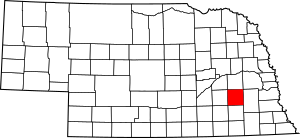Seward County, Nebraska facts for kids
Quick facts for kids
Seward County
|
|
|---|---|
| County of Seward | |

Seward County Courthouse in Seward
|
|

Location within the U.S. state of Nebraska
|
|
| Country | |
| State | |
| Established | March 16, 1855 |
| Organized | October 1865 |
| Named for | William H. Seward |
| County seat | Seward |
| Largest city | Seward |
| Area | |
| • Total | 576 sq mi (1,490 km2) |
| • Land | 571 sq mi (1,480 km2) |
| • Water | 4.5 sq mi (12 km2) 0.8% |
| Highest elevation | 1,598 ft (487 m) |
| Lowest elevation | 938 ft (286 m) |
| Population
(2020)
|
|
| • Total | 17,609 |
| • Density | 30.571/sq mi (11.804/km2) |
| Time zone | UTC−6 (Central) |
| • Summer (DST) | UTC−5 (CDT) |
| Area code | 402/531 |
| FIPS code | 31159 |
| GNIS feature ID | 835901 |
| Website | countyofsewardne.com |
Seward County is a county in the U.S. state of Nebraska, United States. As of the 2020 United States Census, the population was 17,609. Its county seat is Seward. The county was formed in 1855, and was organized in 1867. It was originally called Greene County, and in 1862 it was renamed for William H. Seward, Secretary of State under Abraham Lincoln and Andrew Johnson. Seward County is part of the Lincoln, NE Metropolitan Statistical Area.
In the Nebraska license plate system, Seward County is represented by the prefix 16 (it had the sixteenth-largest number of vehicles registered in the county when the license plate system was established in 1922).
Contents
Geography
The Seward County terrain consists of low rolling hills, largely dedicated to agriculture including center pivot irrigation. The Big Blue River flows south-southeasterly through the central part of the county. The county has a total area of 576 square miles (1,490 km2), of which 571 square miles (1,480 km2) is land and 4.5 square miles (12 km2) (0.8%) is water.
Protected areas
- Bur Oak State Wildlife Management Area
- Freeman Lakes Waterfowl Production Area
- North Lake Basin State Wildlife Management Area
- Oak Glen State Wildlife Management Area
- Tamora Waterfowl Production Area
Demographics
| Historical population | |||
|---|---|---|---|
| Census | Pop. | %± | |
| 1870 | 2,953 | — | |
| 1880 | 11,147 | 277.5% | |
| 1890 | 16,140 | 44.8% | |
| 1900 | 15,690 | −2.8% | |
| 1910 | 15,895 | 1.3% | |
| 1920 | 15,867 | −0.2% | |
| 1930 | 15,938 | 0.4% | |
| 1940 | 14,167 | −11.1% | |
| 1950 | 13,155 | −7.1% | |
| 1960 | 13,581 | 3.2% | |
| 1970 | 14,460 | 6.5% | |
| 1980 | 15,789 | 9.2% | |
| 1990 | 15,450 | −2.1% | |
| 2000 | 16,496 | 6.8% | |
| 2010 | 16,750 | 1.5% | |
| 2020 | 17,609 | 5.1% | |
| 2023 (est.) | 17,671 | 5.5% | |
| US Decennial Census 1790-1960 1900-1990 1990-2000 2010 |
|||
As of the 2000 United States Census, there were 16,496 people, 6,013 households, and 4,215 families in the county. The population density was 29 inhabitants per square mile (11/km2). There were 6,428 housing units at an average density of 11 units per square mile (4.2/km2). The racial makeup of the county was 98.05% White, 0.28% Black or African American, 0.21% Native American, 0.29% Asian, 0.05% Pacific Islander, 0.40% from other races, and 0.72% from two or more races. 1.09% of the population were Hispanic or Latino of any race.
There were 6,013 households, out of which 32.80% had children under the age of 18 living with them, 61.50% were married couples living together, 5.60% had a female householder with no husband present, and 29.90% were non-families. 24.90% of all households were made up of individuals, and 12.10% had someone living alone who was 65 years of age or older. The average household size was 2.53 and the average family size was 3.04.
The county population contained 24.70% under the age of 18, 14.30% from 18 to 24, 24.60% from 25 to 44, 21.20% from 45 to 64, and 15.20% who were 65 years of age or older. The median age was 36 years. For every 100 females, there were 103.20 males. For every 100 females age 18 and over, there were 102.50 males.
The median income for a household in the county was $42,700, and the median income for a family was $51,813. Males had a median income of $32,218 versus $22,329 for females. The per capita income for the county was $18,379. About 4.10% of families and 7.00% of the population were below the poverty line, including 6.20% of those under age 18 and 6.80% of those age 65 or over.
Civil asset forfeiture
Communities
Cities
Villages
Census-designated place
Unincorporated communities
Ghost town
Adjacent counties
- Butler County – north
- Lancaster County – east
- Saline County – south
- Fillmore County – southwest
- York County – west
- Polk County – northwest
See also
 In Spanish: Condado de Seward (Nebraska) para niños
In Spanish: Condado de Seward (Nebraska) para niños

